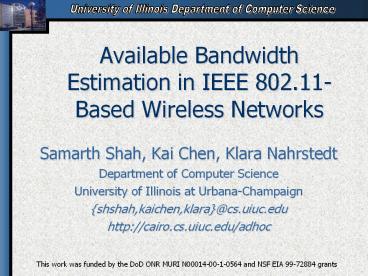Available Bandwidth Estimation in IEEE 802.11-Based Wireless Networks - PowerPoint PPT Presentation
Title:
Available Bandwidth Estimation in IEEE 802.11-Based Wireless Networks
Description:
Wait until medium idle, backoff for collision avoidance, send RTS. RTS-CTS-DATA-ACK. Collision? Increase backoff interval exponentially. Our scheme: ... – PowerPoint PPT presentation
Number of Views:330
Avg rating:3.0/5.0
Title: Available Bandwidth Estimation in IEEE 802.11-Based Wireless Networks
1
Available Bandwidth Estimation in IEEE
802.11-Based Wireless Networks
- Samarth Shah, Kai Chen, Klara Nahrstedt
- Department of Computer Science
- University of Illinois at Urbana-Champaign
- shshah,kaichen,klara_at_cs.uiuc.edu
- http//cairo.cs.uiuc.edu/adhoc
This work was funded by the DoD ONR MURI
N00014-00-1-0564 and NSF EIA 99-72884 grants
2
Introduction
- Theoretical channel capacity depends on the
physical layer - 1, 2, 5.5 or 11 Mbps for IEEE 802.11
- Bandwidth actually available to the application
is less due to - Protocol overhead
- MAC layer contention
- Location-dependent in multi-hop or multi-cell
environments - Location-dependent channel errors
- Signal fading, bit-errors due to physical objects
such as walls, doors, etc.
3
IEEE 802.11 MAC and Our Scheme
- IEEE 802.11 MAC
- Carrier sense
- Medium idle? Send RTS
- Medium busy? Wait until medium idle, backoff for
collision avoidance, send RTS - RTS-CTS-DATA-ACK
- Collision? Increase backoff interval
exponentially - Our scheme
- Does not modify IEEE 802.11 in any way
- Uses data transmissions for bandwidth estimation
- No separate probing packets, etc.
- Performed in the device driver of the wireless
interface - Device driver loaded as a module under Linux
4
Bandwidth Estimation
channel busy, backoff, contention
RTS
CTS
ACK
DATA (size S)
time
ts packet ready
tr packet recvd
- Measured BW S/(tr ts)
- Running average with decay/Average over an
interval - More contention? More time channel sensed as
busy, more RTS/CTS collisions, higher backoffs gt
BW estimate smaller - More channel errors? Bit-errors in RTS/DATA cause
RTS/DATA retransmission gt BW estimate smaller - Only successfully transmitted MAC frames used in
estimate
5
Packet Size
- Packet size affects BW estimate
- Low channel bit-error rate (BER)? Larger packet
size gt higher throughput - High BER? Larger packet size gt Larger
probability of bit-error gt lower throughput - Indexed table of BW estimates for different
packet size ranges - Separate estimation for data and acks (i.e.,
higher-layer acks) at source and destination
respectively
Higher BER
Tput
Lower BER
size
6
Normalization
- For low BERs
- Scenarios used in our simulation and testbed
experiments - Linear part of BER-packet size-throughput curve
- Packet size from 64B to 640B
- We can have a single estimate normalized to a
reference packet size (512B) - Key observations for normalization
- Channel busy backoff RTS/CTS ACK overhead
same for packets of all sizes - Once channel captured, DATA is transmitted at
physical channel rate, for all packet sizes - Normalization enables estimation at source for
both data and acks
7
Simulation Results
- CBR Contention experiments
- Running average with decay
8
Application
- Channel Time Proportion (CTP)
- A link has bandwidth estimate k bps, a flow over
it requires j bps gt it requires a fraction j/k
of the channel shared by nodes in its
neighborhood - Use this in admission control for both single-
and multi-hop IEEE 802.11 networks - Admission control inaccurate
- Admitting new traffic increases contention in the
shared channel - Changes bandwidth estimate of flows
- Dynamic bandwidth management
- For more see
- S. Shah, K. Chen and K. Nahrstedt, Dynamic
Bandwidth Management in Single-hop Ad hoc
Wireless Networks, MONET journal special issue on
Algorithmic Solutions for Wireless, Mobile, Ad
Hoc and Sensor Networks (eds. Bar-Noy, Bertossi,
Pinotti and Raghavendra), 2004. - K. Chen and K. Nahrstedt, EXACT An Explicit
Rate-based Flow Control Framework in MANET,
Technical Report UIUCDCS-R-2002-2286/UILU-ENG-2002
-1730, Department of Computer Science, University
of Illinois at Urbana-Champaign, updated
December, 2002.































